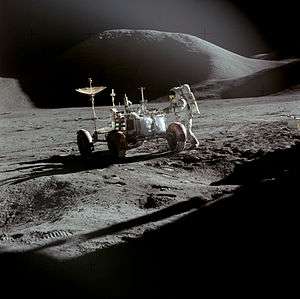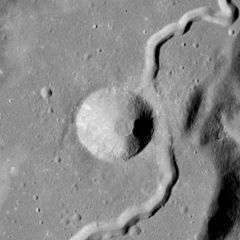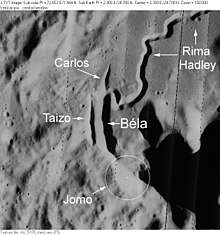Mons Hadley
Mons Hadley is a massif in the northern portion of the Montes Apenninus, a range in the northern hemisphere of the Moon. It has a height of 4.2 km (14,000 ft) above the adjacent plain and a maximum diameter of 25 km at the base.[1]
| Mons Hadley | |
|---|---|
 | |
| Highest point | |
| Elevation | 9407 m (summit)[1] |
| Listing | Lunar mountains |
| Coordinates | 26.69°N 4.12°E[2] |
| Geography | |
| Location | the Moon |


To the southwest of this mountain is a valley that served as the landing site for the Apollo 15 expedition. To the southwest of this same valley is the slightly smaller Mons Hadley Delta (δ) peak with a height of about 3.5 km above the valley floor. Mons Hadley Delta was visited and sampled by the astronauts, but Mons Hadley itself was only photographed from the surface. To the west of these peaks is the sinuous Rima Hadley rille.
These features were named after the English mathematician John Hadley.[3]
Rima Hadley
This sinuous lunar rille follows a course generally to the northeast, toward the Mons Hadley peak, for which it is named. This feature is centered at selenographic coordinates 25.0° N, 3.0° E, and lies within a diameter of 80 km. It begins at the crater Béla, an elongated formation with the long axis oriented to the northwest.
Nearby craters

Four small craters near this rille have been assigned names by the IAU. These are listed in the table below.
| Crater | Coordinates | Diameter | Name source |
|---|---|---|---|
| Béla | 24.7°N 2.3°E | 11 × 2 km | Hungarian masculine name |
| Carlos | 24.9°N 2.3°E | 4 km | Spanish masculine name |
| Jomo | 24.4°N 2.4°E | 7 km | African masculine name |
| Taizo | 24.7°N 2.2°E | 6 km | Japanese masculine name |
Satellite craters
By convention these features are identified on lunar maps by placing the letter on the side of the crater midpoint that is closest to Mons Hadley.
| Hadley | Latitude | Longitude | Diameter |
|---|---|---|---|
| C | 25.5° N | 2.8° E | 6 km |
The crater Joy was formerly known as Hadley A, prior to being renamed by the IAU in 1973.[4]
References
- LTO-41B4 Hadley — L&PI Lunar Topographic Orthophotomap
- Mons Hadley, Gazetteer of Planetary Nomenclature, International Astronomical Union (IAU) Working Group for Planetary System Nomenclature (WGPSN)
- "Mons Hadley". Gazetteer of Planetary Nomenclature. USGS Astrogeology Research Program.
- Gazetteer of Planetary Nomenclature, International Astronomical Union (IAU) Working Group for Planetary System Nomenclature (WGPSN), Joy Feature 2851
- Andersson, L. E.; Whitaker, E. A. (1982). NASA Catalogue of Lunar Nomenclature. NASA RP-1097.CS1 maint: ref=harv (link)
- Bussey, B.; Spudis, P. (2004). The Clementine Atlas of the Moon. New York: Cambridge University Press. ISBN 978-0-521-81528-4.CS1 maint: ref=harv (link)
- Cocks, Elijah E.; Cocks, Josiah C. (1995). Who's Who on the Moon: A Biographical Dictionary of Lunar Nomenclature. Tudor Publishers. ISBN 978-0-936389-27-1.CS1 maint: ref=harv (link)
- McDowell, Jonathan (July 15, 2007). "Lunar Nomenclature". Jonathan's Space Report. Retrieved 2007-10-24.CS1 maint: ref=harv (link)
- Menzel, D. H.; Minnaert, M.; Levin, B.; Dollfus, A.; Bell, B. (1971). "Report on Lunar Nomenclature by the Working Group of Commission 17 of the IAU". Space Science Reviews. 12 (2): 136–186. Bibcode:1971SSRv...12..136M. doi:10.1007/BF00171763.CS1 maint: ref=harv (link)
- Moore, Patrick (2001). On the Moon. Sterling Publishing Co. ISBN 978-0-304-35469-6.CS1 maint: ref=harv (link)
- Price, Fred W. (1988). The Moon Observer's Handbook. Cambridge University Press. ISBN 978-0-521-33500-3.CS1 maint: ref=harv (link)
- Rükl, Antonín (1990). Atlas of the Moon. Kalmbach Books. ISBN 978-0-913135-17-4.CS1 maint: ref=harv (link)
- Webb, Rev. T. W. (1962). Celestial Objects for Common Telescopes (6th revision ed.). Dover. ISBN 978-0-486-20917-3.CS1 maint: ref=harv (link)
- Whitaker, Ewen A. (1999). Mapping and Naming the Moon. Cambridge University Press. ISBN 978-0-521-62248-6.CS1 maint: ref=harv (link)
- Wlasuk, Peter T. (2000). Observing the Moon. Springer. ISBN 978-1-85233-193-1.CS1 maint: ref=harv (link)
External links
| Wikimedia Commons has media related to Mons Hadley. |
- LTO-41B4 Hadley — L&PI Lunar Topographic Orthophotomap